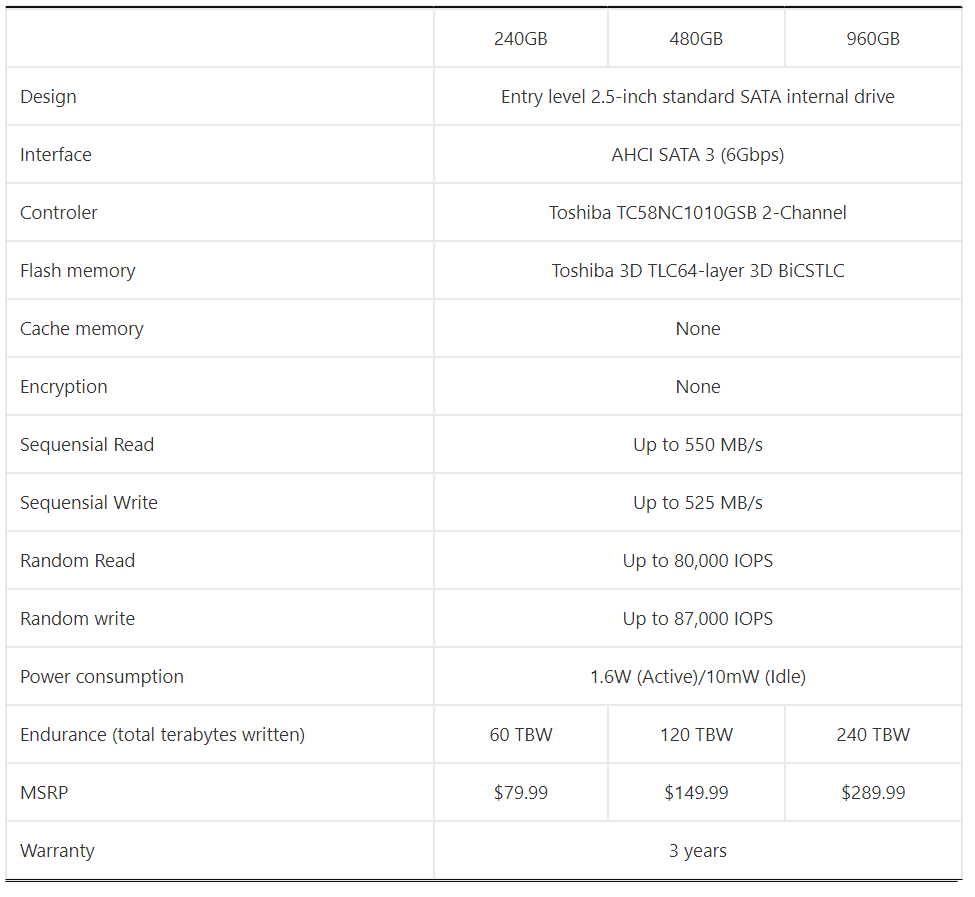I didn’t have high expectations of the Toshiba OCZ TR200 Solid-State Drive (SSD) thanks to its modest specs. The drive indeed ended up being one of the slowest SSDs in my formal tests. But don’t write it off just yet! If you have an aging computer and want to get a decent amount of new meaningful life out of it, read on!

Entry-level specs, helpful software
Toshiba told me that the TR200 is supposed to be an entry-level “value” drive, and its specs show just that. This is the first SSD I’ve known that doesn’t have any cache memory, a hardware part that helps boost performance.

The TR200 uses Toshiba’s TLC 64-layer 3D BiCSTLC flash memory. In a nutshell, in 3D flash, the memory cells are stacked up—up to 64 layers in the case of the TR200—to allow significantly more density than the traditional 2D planar type of flash memory. This translates into more storage space at a lower cost.

The TR200’s suggested retail price isn’t the lowest on the market, averaging about 30 cents per gigabyte, but expected to be lower the longer the drive stays on the market. The endurance—the amount of data that can be written to the drive before it becomes unreliable—is quite good for an entry-level drive. Toshiba guarantees that if you write 50GB per day and every day to the 240GB version of the TR200, it will take you more than three years to deplete its endurance. You can get double and quadruple endurance out of the 480GB and 980GB versions, respectively.
The drive uses the standard SATA 2.5-inch design and will fit in any application where a regular hard drive of the same standard is used. It comes with Toshiba’s helpful SSD Utility software, which you can use to check on its condition quickly, update its firmware, and so on. The software only works with Windows, but in my testing, the TR200 also works well with Mac and Linux.
Slow performance
The TR200 has nothing to show among recent SSDs. In sequential (copy) tests, it was the slowest I’ve seen, especially in tests where it needed to do both writing and reading at the same time, averaging just around 95 MB/s. It’s the first SSD I’ve known that scored below 100 MB/s in this test.

In the random access test, the drive managed to perform a bit faster than the WD Blue in the write operation, but in reading, it was again at the bottom of the charts.

The real-world test
As part of my SSD testing process, I try out the review drive in a variety of applications, one of which is an old MacBook Pro 13″ (mid-2009 version). The laptop is so old that it doesn’t support OS X newer than El Capital (10.11). It also uses the older SATA 2 (3Gbps).
Originally this laptop runs on a Fujitsu hard drive and needs more than a minute to boot up fully. Every app on the computer takes ages to launch (exaggeration intended). This is where an SSD upgrade will bring about marked improvement, and I put the TR200 through the same process to see how it’d fair compared with other drives.

If you have a similar computer (basically any Mac that still runs on a hard drive,) I recommend you do the same. The replacement process was easy as long as you have a USB-to-SATA adapter and a set of screwdrivers. Here are the steps:
- Plug the new SSD into the computer using the USB-to-SATA adapter.
- Run Disk Utility (search for it using Spotlight) and format/erase the new SSD into “OS X Extended (Journal)” partition.
- Download and install SupperDupper! (the trial version will do)
- Run SupperDupper! and choose to “Backup – all files” from the Mac’s internal drive onto the new SSD. Wait for the copy to be done, which can take a while, depending on the amount of data on the computer’s original drive.
- Turn off the computer, open its case, and replace the internal drive with the new SSD, close it back up. While this sounds like a lot of work, it’s quite easy as long as you have the right set of screwdrivers for your particular Mac.

And the result was gratifying, the computer now took just about 25 seconds to boot, and everything was moving along nicely. What was most impressive is the fact that the improvement was the same as when I used the Samsung 860 Pro on the laptop. The Samsung is a high-end SSD that tops the performance charts and costs significantly more.
Toshiba OCZ TR200's Rating

Pros
Excellent replacement drive for an aging computer
Relatively inexpensive
Useful software
Cons
One of the slowest SSDs on the market
Conclusion
If you have an older generation computer, be it a Mac or a Windows machine, an expensive SSD can only do so much before dismissing return.
In this case, an entry-level drive like the TR200 is the best bang for your buck.
Note that I used a 480GB version of the drive for this review, but a 240 GB version will work too, as long as you have less than 200 GB of data on the old computer’s original drive.
For less than $80, you can now keep and enjoy your laptop for a few more years. That’s an investment worth every penny.



Comments are subject to approval, redaction, or removal. You're in the no-nonsense zone and that applies BOTH ways.
It's generally faster to get answers via site/page search. Your question/comment is one of many Dong Knows Tech receives daily.
Thank you!
(•) If you have subscription-related issues or represent a company/product mentioned here, please use the contact page or a PR channel.